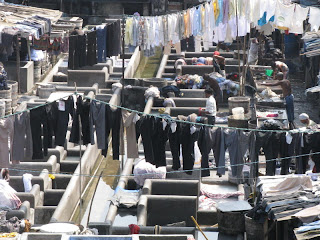A 1 hour boat trip from the Gateway of India took us to Elephanta Island. The carvings in the caves are over 1,000 years old and are dedicated to the Goddess Shiva. On our trip to Elephanta our guide explained (and I’ll paraphrase here) that Hindus come into this world like all babies, with their fists closed crying and ready for the fight, and learn through the Hindu philosophy to open their hands in a giving up gesture to all materialism; never to expect anything. It just doesn’t matter. Of course this is a bunch of bull because if you’re sleeping on cardboard it does matter. However wherever you are in this city, in the worst of the worst slum, you will find tucked away a temple covered with beautiful flowers and filled with wonderful smells Again the dhicitomy of this philosophy showed up at the Dhobi Ghats, the communal washing area. As explained by our guide she herself has a washer and dryer but still sends out her bedspreads and sheets to be washed by hand, along the rock cubicles at the dhoby ghats because the people need the work. Many large restaurants use them as well. So here you have an uneducated underclass that will always exist because the upper castes’ want them to. From our point of view we would tear this down, build a Laundromat and teach the people to work in it. We learned that there are only two types of pedestrians-the quick and the dead. I’ll provide a few facts so that the pictures have some context to them.
The area was originally appropriated by the Portuguese and later ceded to the British East India Trading company in 1661. Under Ghandi’s policy of non cooperation, India won its Independence in 1947. Today it is 88% Hindu; the majority of Muslim’s moving to and creating Pakistan not long after Independence.
Over 400 families a day come to Mumbai looking for work. They initially must live on the streets and within a few days begin building a home made from discards in the slums. Today, over half the population live in the slums without running water or toilet facilities. Even 40% of the police force live in the slums. The caste system still exists. An example is the Fisherman’s slum which you will see in the pictures I’ve posted. Only fisherman may live there. The more established have a better dwelling. You find slums concentrated in some areas and often mixed in among richer areas. However the children don’t seem to care where they live and love getting their pictures taken if only to look at the digital images afterward. Our taxi driver, Babu, took us to the top of Malabar hill (where the wealthier population lives) to see the home of the Kingfisher beer magnate atop the highest point in the city.
Finally, you will see some pictures related to the Terrorist attacks that took place over our Thanksgiving Weekend. There were hundreds killed over the 3 days and the city is still recovering. The Taj Hotel is partially open and we were able to get some pictures of this. In addition, Victoria Station, opened within a week but is still undergoing repair. The Jewish Synagogue is closed and is not likely to open to the public in the near future. It appears to me that the Indian Security was lax and the high speed boats came through the main harbor and landed at the foot of Fishermans wharf within a half mile of the Gateway of India. Security was certainly beefed up but it appeared to me that it was still not as strong as we’ve observed in other countries.
Our next posting will be of Dubai.






















































No comments:
Post a Comment